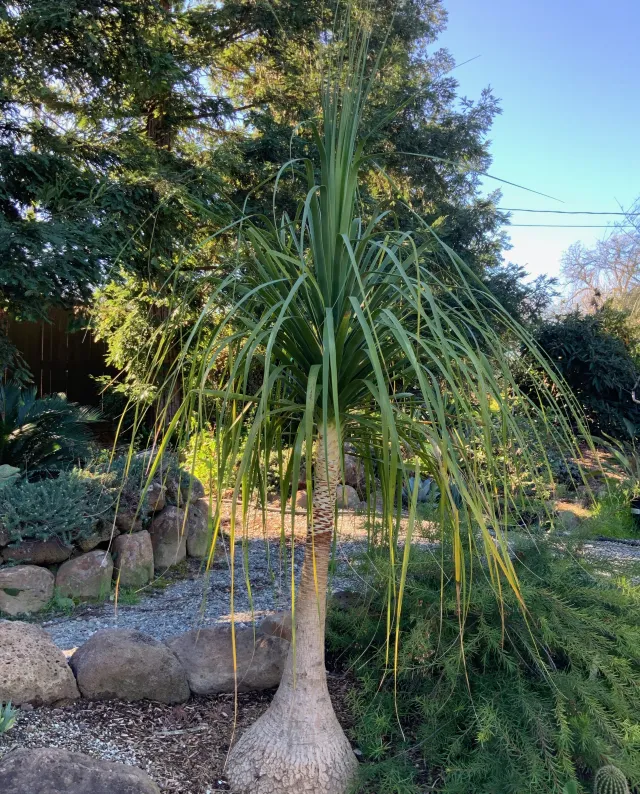Ponytail Palm
Palm Overview
Botanical Name: Beaucarnea recurvata
Bring a Touch of the Exotic to Your Space with the Stunning Ponytail Palm!
Looking for a plant that turns heads and practically takes care of itself? Meet the Ponytail Palm (Beaucarnea recurvata)—a bold, sculptural beauty that’s equal parts art piece and low-maintenance companion.
Despite its name, the Ponytail Palm isn’t actually a palm—it’s a drought-tolerant succulent with a dramatic flair. Its most striking feature is its bulbous, bottle-shaped trunk, which stores water and gives it a unique, architectural look. From the top bursts a fountain of long, slender, curly green leaves, cascading down like a ponytail in motion—hence the name!
Whether you’re styling a modern loft, cozy home office, or sun-drenched patio, this plant makes a statement. It thrives on neglect, needing only occasional watering and bright indirect light—making it perfect for beginners or busy plant lovers. Even better? It’s non-toxic to humans, and very slow-growing, so it won’t outgrow its space.
Plant Characteristics
| Factor | Requirements |
|---|---|
| Sunlight | Prefers bright, indirect light indoors; full sun to partial shade outdoors |
| Soil | Well-draining soil; sandy or cactus/succulent mix is ideal |
| Watering | Low – allow soil to dry out completely between waterings; water sparingly, especially in winter |
| Hardiness | USDA Zones 9–11 (tolerates temperatures down to ~20°F for short periods) |
Environmental Needs
| Condition | Description |
|---|---|
| Sunlight | Full sun (needs at least 6–8 hours per day) |
| Soil | Well-draining soil, tolerates sandy or loamy soils |
| Watering | Drought-tolerant once established, but benefits from regular deep watering in hot/dry climates |
| Hardiness | USDA Zones 9–11; cold-hardy down to about 20°F (-6°C) briefly |
Fruit and Flowering
| Category | Details |
|---|---|
| Flowers | Small, creamy-white to yellowish flowers that grow in large, branching clusters (panicles) |
| Sex | Dioecious – male and female flowers occur on separate plants |
| Time to Flower | May take 10–30 years to flower, typically only outdoors in warm climates |
| Fruiting | Only female plants produce small, dry, seed-bearing capsules after flowering |
| Bloom Season | Late spring to early summer (in ideal outdoor conditions) |
Uses
Indoor Decorative Plant – Adds a striking, sculptural element to homes, offices, and lobbies
Outdoor Accent Plant – Great focal point for patios, courtyards, xeriscapes, or desert-style gardens (in warm climates)
Container Gardening – Thrives in pots and containers, making it easy to move and style
Low-Maintenance Landscaping – Ideal for water-wise gardens and low-irrigation landscapes
Bonsai Styling – Sometimes grown as a novelty bonsai due to its dramatic trunk and slow growth
Air-Purifying Qualities – Contributes to cleaner indoor air (like many houseplants)
Conversation Piece – Unique look draws attention and curiosity
Gift Plant – Popular as a long-lasting, easy-care gift for plant lovers
Maintenance
Watering:
Allow soil to dry completely between waterings
Water thoroughly, but infrequently (every 2–4 weeks)
Reduce watering in winter
Lighting:
Provide bright, indirect sunlight indoors
Can tolerate full sun outdoors in warm climates
Rotate periodically for even growth
Soil Care:
Use well-draining, sandy or cactus mix
Avoid compact or moisture-retentive soils
Fertilizing:
Feed sparingly—use a balanced liquid fertilizer once in spring and once in summer
Avoid over-fertilizing, as growth is naturally slow
Pruning:
Minimal pruning needed
Trim brown leaf tips for tidiness
Do not cut the top of the trunk—it won’t regrow
Repotting:
Repot every 3–5 years or when root-bound
Choose a pot with drainage holes
Pests & Diseases:
Generally pest-resistant
Watch for mealybugs or root rot if overwatered
Temperature:
Protect from frost (below 40°F)
Can live outdoors year-round in USDA zones 9–11
